

Lemuria (continent) The idea of Lemuria was subsequently incorporated into the proto-New Age philosophy of Theosophy and subsequently into general fringe belief.
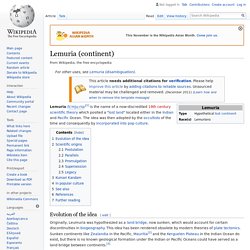
Accounts of Lemuria here differ. All share a common belief that a continent existed in ancient times and sank beneath the ocean as a result of a geological, often cataclysmic, change, such as pole shift, which such theorists anticipate will destroy and transform the modern world. Other scientists hypothesized that Lemuria had extended across parts of the Pacific oceans, seeking to explain the distribution of various species across Asia and the Americas. The Lemuria theory disappeared completely from conventional scientific consideration after the theories of plate tectonics and continental drift were accepted by the larger scientific community.
Book of Dzyan. The Book of Dzyan (comprising the Stanzas of Dzyan) is a reputedly ancient text of Tibetan origin.

The Stanzas formed the basis for The Secret Doctrine (1888), one of the foundational works of the theosophical movement, by Helena Petrovna Blavatsky. Lemuria. Lemuria, Atlantyda i Agarta. {*style:<b> ZAGINIONE CYWILIZACJE - LEMURIA, ATLANTYDA I AGARTA </b>*} Jakoż od dawna interesowała mnie tematyka zaginionych cywilizacji, postanowiłam sięgnąć do różnych książek, aby zgłębić ten temat. Mimo dużych możliwości dzisiejszych czasów, a mam na myśli w szczególności Internet, postanowiłam sięgnąć do książek, które wydają mi się źródłem bardziej stabilnym aniżeli Sieć, w której z reguły można znaleźć mnóstwo króciutkich wzmianek, nie wystarczająco rozwijających tą tematykę.
LEMURIA. Rozwój i upadek Lemurii nie jest nigdzie dokumentowany.
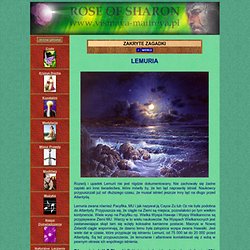
Kumari Kandam. References[edit] References from literary sources[edit]

Louis Jacolliot. Louis Jacolliot (31 October 1837 – 30 October 1890) was a French barrister, colonial judge, author and lecturer.
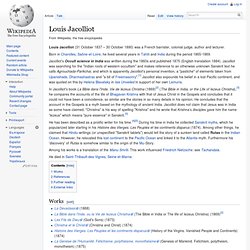
Born in Charolles, Saône-et-Loire, he lived several years in Tahiti and India during the period 1865-1869. In Jacolliot's book La Bible dans l'Inde, Vie de Iezeus Christna (1869)[2] (The Bible in India, or the Life of Iezeus Christna),[3] he compares the accounts of the life of Bhagavan Krishna with that of Jesus Christ in the Gospels and concludes that it could not have been a coincidence, so similar are the stories in so many details in his opinion.
He concludes that the account in the Gospels is a myth based on the mythology of ancient India. Jacolliot does not claim that Jesus was in India as some have claimed. "Christna" is his way of spelling "Krishna" and he wrote that Krishna's disciples gave him the name 'Iezeus" which means "pure essence" in Sanskrit.[3] Among his works is a translation of the Manu Smriti. Tschandala. Tschandala (old German transcription of chandala) is a term Friedrich Nietzsche borrowed from the Indian caste system, where a Tschandala is a member of the lowest social class.
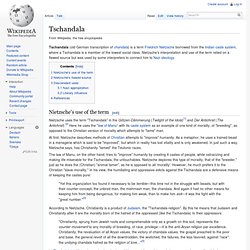
Nietzsche's interpretation and use of the term relied on a flawed source but was used by some interpreters to connect him to Nazi ideology. Ignatius Donnelly. Antediluvian World by Ignatius Donnelly. Copyright laws are changing all over the world.
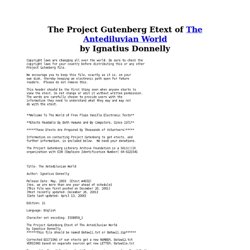
Be sure to check the copyright laws for your country before distributing this or any other Project Gutenberg file. We encourage you to keep this file, exactly as it is, on your own disk, thereby keeping an electronic path open for future readers. Please do not remove this. This header should be the first thing seen when anyone starts to view the etext. Do not change or edit it without written permission. [Redactor's Note: This text version of "Atlantis, the Antediluvian World" was prepared from input provided by Mr. Inline Mayan glyphs in Part III Chapter 7 have been replaced by '###'. Figure captions are retained as text in capital letters centered on the page set off by blank lines. The line length is 73 characters, but one table in Part II Chap V unavoidably had to be extended to 107 characters.]
Pierścień Atlantów. {*style:<b>PIERŚCIEŃ ATLANTÓW </b>*} Atlantis. Fictional island in Plato's works, now a synonym for supposed prehistoric lost civilizations Athanasius Kircher's map of Atlantis, placing it in the middle of the Atlantic Ocean, from Mundus Subterraneus 1669, published in Amsterdam.

The map is oriented with south at the top. While present-day philologists and classicists agree on the story's fictional character,[9][10] there is still debate on what served as its inspiration. As for instance with the story of Gyges,[11] Plato is known to have freely borrowed some of his allegories and metaphors from older traditions. Plato's dialogues Timaeus A fifteenth-century Latin translation of Plato's Timaeus.
Thomas Lake Harris. Thomas Lake Harris (May 15, 1823 – March 23, 1906) was an American mystic, spiritualistic prophet and poet.

Biography[edit] Early life[edit] Harris was born at Fenny Stratford in Buckinghamshire, England. His parents were Calvinistic Baptists, and very poor. They settled at Utica, New York, when Harris was five years old. Preaching[edit] About 1850 Harris professed to receive inspirations, and published some long poems. Commune[edit] In Brocton, Harris established a winemaking industry.
Later years[edit] Harris took part of the community to Santa Rosa, California, where he created the Fountain Grove community in about 1875. Dissension and influence[edit]